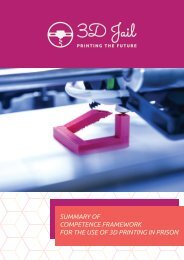3D Jail Project - IO1 - Competence framework for 3D printing in jail
Intellectual Output 1 The main innovative element of IO1 is to entail professionalizing competencies on the use of 3D printing technologies in the learning context of people with fewer opportunities because of their status of prisoners, ex-prisoners or subjected to alternative measures to detention. It is innovative because – in a pioneering way in Europe – it puts the basis to frame this kind of competencies in relation with restricted people, in the context of prison security, and it challenges penitentiary administrations to innovate their procedures and conditions to use even more ICT technologies inside their structures. It also poses prisons’ educational systems before the challenge to include these specific competencies in the educational experience of the inmates.
Intellectual Output 1 The main innovative element of IO1 is to entail professionalizing competencies on the use of 3D printing technologies in the learning context of people with fewer opportunities because of their status of prisoners, ex-prisoners or subjected to alternative measures to detention. It is innovative because – in a pioneering way in Europe – it puts the basis to frame this kind of competencies in relation with restricted people, in the context of prison security, and it challenges penitentiary administrations to innovate their procedures and conditions to use even more ICT technologies inside their structures. It also poses prisons’ educational systems before the challenge to include these specific competencies in the educational experience of the inmates.
- No tags were found...
You also want an ePaper? Increase the reach of your titles
YUMPU automatically turns print PDFs into web optimized ePapers that Google loves.
European document made some concepts common and shared, such as:<br />
●<br />
●<br />
●<br />
●<br />
●<br />
<strong>Competence</strong>, based on knowledge and skills<br />
Formal learn<strong>in</strong>g<br />
Non <strong>for</strong>mal learn<strong>in</strong>g<br />
In<strong>for</strong>mal learn<strong>in</strong>g<br />
Learn<strong>in</strong>g outcomes<br />
These concepts are the components to describe occupations (professional profiles) and<br />
qualifications, adopted <strong>in</strong> most European countries, and <strong>in</strong> the European repository ESCO –<br />
European Skills/<strong>Competence</strong>s, qualifications and Occupations.<br />
Qualifications are compared on a European level through the European Qualification<br />
Framework (EQF, revised <strong>in</strong> 2017); Each country edit a National Qualification Framework<br />
with reference to the European one, <strong>in</strong> order to make each system connect to the other. An<br />
automatic recognition of the qualifications on a European level is the f<strong>in</strong>al goal, but it is still<br />
on the way to go.<br />
Recently, beyond the certification of the <strong>for</strong>mal learn<strong>in</strong>g, an <strong>in</strong>creas<strong>in</strong>g attention is paid to<br />
the recognition of non-<strong>for</strong>mal and <strong>in</strong><strong>for</strong>mal learn<strong>in</strong>g. The <strong>jail</strong> environment is often<br />
<strong>in</strong>terested by this k<strong>in</strong>d of learn<strong>in</strong>g; the recognition of the competences acquired <strong>in</strong> this<br />
environment with blended tra<strong>in</strong><strong>in</strong>g is gett<strong>in</strong>g <strong>in</strong>creas<strong>in</strong>gly relevant, especially <strong>for</strong> the<br />
particular target we aim to, which is <strong>in</strong>cluded <strong>in</strong> the greater category of people with fewer<br />
opportunities.<br />
The recognition of the acquired competencies can be declared by the learner, by the<br />
organisation that supplies the tra<strong>in</strong><strong>in</strong>g or the validation path, or by a public <strong>in</strong>stitution.<br />
Respectively the recognition has different values; first, second and third party. The<br />
Identification, Documentation, Assessment and Certification steps are already adopted <strong>in</strong><br />
many countries and others are go<strong>in</strong>g to consolidate this practice <strong>for</strong> the recognition of<br />
competencies acquired <strong>in</strong> <strong>for</strong>mal, non-<strong>for</strong>mal and <strong>in</strong><strong>for</strong>mal learn<strong>in</strong>g.<br />
On a different, opposite, side there is the recognition of the market, of the employers. Some<br />
certification issued by private organisations, national or <strong>in</strong>ternational, are recognized <strong>for</strong><br />
their seriousness and their clear content so that they are valuable documents <strong>in</strong> the labour<br />
market.<br />
The convergence of these two k<strong>in</strong>ds of recognition is a great challenge <strong>for</strong> the National and<br />
European VET and certification systems.<br />
33





